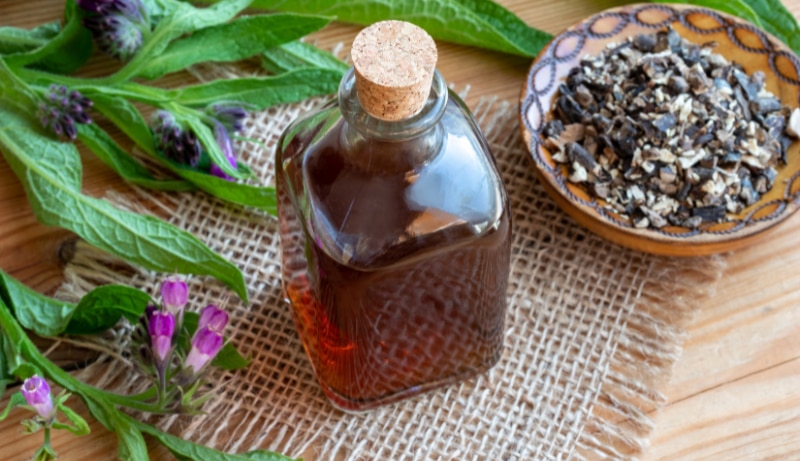10% off £35
Comfrey oil benefits

Comfrey oil is a herbal oil that moisturises skin, and that’s been used as a healing herb for a long time.1
Since at least the 4th century, people have used comfrey medicinally. Medicine makers would bind comfrey leaves and roots in poultices, then apply those poultices to the skin to treat injuries. The first European settlers of America considered comfrey so indispensable, they carried it on their journey across the Atlantic in the 1600s.2
Modern science suggests that the ancients were correct in believing comfrey helps to heal wounds and relieve pain.3,4 In this article, we’ll explain where comfrey comes from, comfrey oil’s remarkable health benefits and how to use it at home. Finally, we’ll warn of any side effects associated with comfrey oil.
What is comfrey oil?
What is comfrey oil?
Comfrey is a flowering shrub that grows in Europe, Asia and, now, North America. The roots and leaves of the comfrey plant have medicinal properties.
Comfrey oil is made by infusing the leaves and roots of a comfrey plant with a neutral oil. Most comfrey oils keep for around 2 years after production.


Benefits of comfrey oil
Topically applied comfrey oil is associated with a wide range of health benefits and can help with certain issues including:
-
Grazes
Comfrey oil is good at helping with superficial cuts, scratches, and scrapes. Children, who suffer from these injuries the most, are statistically unlikely to have adverse reactions to comfrey oil when used on scrapes.5
-
Fractures
When comfrey was applied topically to animals above where they’d suffered bone fractures, their bones healed at a much-improved rate than animals who hadn’t been treated with comfrey.6
-
Encourages leg ulcer recovery
Leg ulcers are uncomfortable, prone to infection, and can take a long time to heal. Scientific studies have shown comfrey oil can help reduce the likelihood leg ulcers will become infected.7
-
Back discomfort
Topical application of comfrey oil has been shown to support the lower and upper back more than methyl nicotinate, the main ingredient in many muscle creams.8
Comfrey oil uses
Comfrey oil should be applied topically to parts of the body where you have muscular pain or discomfort.
Potential comfrey oil side effects
Comfrey oil shouldn’t be used for cooking, like other types of cooking oil. Ingesting cooking oil has been banned by the European Union, due to a high risk of liver toxicity.9
Adults with liver disease, cancer, or a history of alcoholism are also advised to avoid comfrey because the skin can also absorb the liver-damaging compounds. However, not a rate considered harmful for those with healthy livers.10,11
Last updated: 23 March 2021
- https://www.ncbi.nlm.nih.gov/pmc/articles/PMC5908267/
- http://www.missouribotanicalgarden.org/PlantFinder/PlantFinderDetails.aspx
- http://www.sciencedirect.com/science/article/pii/S0965229913001672
- http://www.ncbi.nlm.nih.gov/pubmed/22887778
- https://www.ncbi.nlm.nih.gov/pmc/articles/PMC6363250/
- https://www.ncbi.nlm.nih.gov/pmc/articles/PMC6631335/
- https://www.ncbi.nlm.nih.gov/pmc/articles/PMC6631335/
- https://pubmed.ncbi.nlm.nih.gov/22887778/
- https://www.ema.europa.eu/en/documents/herbal-report/final-assessment-report-symphytum-officinale-l-radix_en.pdf
- http://pennstatehershey.adam.com/content.aspx?productid=107&pid=33&gid=000234
- https://www.ema.europa.eu/en/documents/herbal-report/final-assessment-report-symphytum-officinale-l-radix_en.pdf














